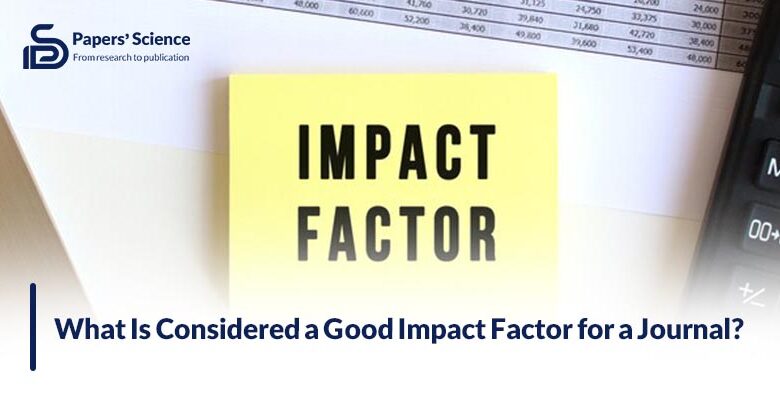What Is Considered a Good Impact Factor for a Journal?

W hen seeking publication opportunities, many researchers focus on journals with high impact factors (IFs), thinking that these prestigious publications will bring more recognition to their work.
A higher and good IF suggests that a journal publishes influential research, but it’s essential to consider the specific research area and the type of study being evaluated.
The impact factor assesses a journal’s quality based on the average number of times articles published in the journal over the past two years are cited by other scholarly works. In the realm of academic journals and research, a high-impact factor is considered a mark of distinction.
Now let’s see what exactly is the Impact Factor and what is considered a good impact factor for a journal?
What Is an Impact Factor or IF?
The impact factor (IF) stands as a widely recognized metric, and it assesses a journal’s influence and quality based on the average number of times other scholarly works cite its articles over two years.
While a higher Impact Factor generally denotes a more prestigious and influential journal, it’s essential to consider the specific field of study and the nature of the research being evaluated.
How Can You Calculate the Impact Factor?
You need 2 metrics to calculate the IF of a journal and a simple formula. Just as mentioned below.
1. Total Citable Items
This metric represents the total number of articles published by the journal in the past 2 years that are eligible for citation. These articles are typically peer-reviewed and considered to make significant contributions to the field.
2. Total Citation Count
This metric measures the total number of times articles published by the journal in the past 2 years have been cited by other scholarly works. A higher citation count indicates that the journal’s articles are being widely read and considered influential within the field.
Now, what is the formula to calculate the Impact Factor?
3. Calculating the Impact Factor
The impact factor is calculated by dividing the total citation count by the total citable items. This ratio provides an average measure of how often an article published in the journal is cited over two years.
· How to Understand the Impact Factor?
A higher impact factor generally indicates that the journal publishes more influential research that is widely read and cited by other scholars. Let’s go deeper and find out what is considered a good impact factor for a journal.

What’s a good Impact Factor for a journal?
The impact factor initially intended to help librarians select relevant academic journals, has gained immense importance in today’s academic landscape.
With thousands of journals publishing countless articles and papers annually, it becomes challenging to distinguish top-tier publications from those of lesser quality. That’s where the impact factor plays a crucial role.
However, defining a “good” impact factor for a journal depends on the specific discipline and the journal’s specialization. A journal with a high IF within its field is more likely to garner citations and recognition compared to others within the same domain.
In essence, the impact factor serves as a valuable indicator of a journal’s “influence” and “quality”, helping researchers and academics make informed decisions about their publishing choices.
What is the median for Impact Factor in a journal?
In 2023, the median IF across all 231 categories was 3.51, indicating that half of the journals had an IF within this range. The IF ranged from above 4 in some specialized fields to lower than 3 in the broader general categories.
An Impact Factor of 10 is widely considered exceptional, though it’s rarely achieved in many disciplines. Due to the statistics, only 3.57% of journals had an IF of 10 or higher in 2023.
Even a remarkable Impact Factor score like 10 for a journal may not be the highest achievable. The CA-A Cancer Journal for Clinicians holds the record for the highest IF in 2023, with an astonishing 549.828, while Nature Reviews Materials secured an Impact Factor of 72.601.
The main types of impact factors and metrics used to assess a journal’s quality:
1. Journal Impact Factor (JIF)
2. Eigenfactor Score (ES)
3. Immediacy index
4. Source Normalized Impact per Paper (SNIP)
5. CiteScore
6. Article Influence Score
Now that you are familiar with the impact factor, how to calculate it, and what is considered a high IF for a journal, let’s end the conversation here.
Read More: Do You Get Paid for Publishing a Research Paper?
In conclusion
Understanding what qualifies as a “good” journal impact factor can be subjective. This might stem from the ambitious goals of certain researchers or the lack of awareness among others.
An impact factor can be a helpful reference point in decision-making, but it’s crucial to put it in the right context.
Beyond just the high impact factor in a journal, several other factors should be taken into account when assessing articles published in any journal that we mentioned in this comprehensive guide.

If you have anything to add to the “What Is Considered a Good Impact Factor for a Journal?” topic, please comment us.



